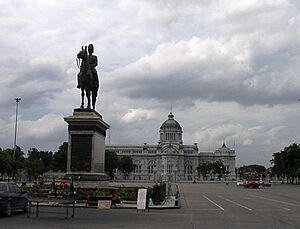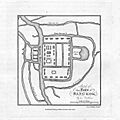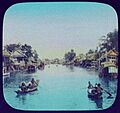History of Bangkok facts for kids
Quick facts for kids Timeline |
|
|---|---|
| c 14th century | Settlement of Bangkok |
| c 1538 | Construction of river bypass canal |
| 1688 | Siege of Bangkok expels French garrison |
| 1767 | Fall of Ayutthaya; Taksin establishes Thonburi as capital |
| 1782 | Phutthayotfa Chulalok moves capital to eastern bank |
| 1820 | Cholera pandemic kills 30,000 |
| 1849 | Cholera again devastates population |
| 1864 | First paved road constructed |
| 1893 | Paknam railway opens |
| 1893 | Paknam Incident & French blockade |
| 1894 | Electric trams begin service |
| 1914 | Beginning of city water supply |
| 1924 | Don Mueang Airport opens |
| 1932 | Memorial Bridge opens |
| 1932 | Coup ends absolute monarchy |
| 1941–45 | Bombing of Bangkok in World War II |
| 1942 | City-wide flooding lasts 2 months |
| 1966 | Bangkok hosts the 5th Asian Games |
| 1968 | First high-rise building constructed |
| 1972 | Merger of Phra Nakhon and Thonburi Provinces |
| 1975 | Establishment of Bangkok Metropolitan Administration |
| 1981 | First expressway opens to service |
| 1985 | First governor election |
| 1990 | Gas truck explodes on New Petchburi Road |
| 1998 | Bangkok hosts Asian Games for the fourth time |
| 1999 | First mass-rapid transit line in Bangkok opens (BTS Sukumvit and Silom Lines) |
| 2011 | Severe floods inundate parts of city |
| 2015 | August 2015 Bangkok bombing kills 23 in Thailand's deadliest-ever single terrorist attack |
The history of Bangkok goes back a long way, at least to the early 1400s. Back then, it was part of the Ayutthaya Kingdom. Bangkok is located near the mouth of the Chao Phraya River, which made it a very important place for trade.
After Ayutthaya fell, King Taksin made Thonburi his new capital in 1767. Thonburi was on the west side of the river. Later, in 1782, King Phutthayotfa Chulalok moved the capital to the east side. This is when the city got its current Thai name, "Krung Thep Maha Nakhon".
Since then, Bangkok has changed a lot. It grew very quickly, especially in the last half of the 1900s. It became the most important city in Thailand. Bangkok was also key to Thailand's modernization in the late 1800s. It was bombed during World War II and has often been the center of political changes in Thailand.
Contents
Early Days Under Ayutthaya
It's not clear exactly when people first settled in the area that is now Bangkok. It likely started as a small village for farming and trading. It was located on a bend of the Chao Phraya River. By the 1400s, it was an important customs checkpoint for the Ayutthaya Kingdom.
The river used to flow through what are now the Bangkok Noi and Bangkok Yai canals. This created a big loop where the town was located. Around 1538 or 1542, a new canal was dug. This canal cut through the loop, making the journey shorter for ships going to Ayutthaya. The river's path changed to follow this new canal. This split the town, making the western part an island.
This island feature might be why the town was called Bang Ko, meaning 'island village'. This name later became Bangkok. Another idea is that the name comes from Bang Makok. Makok is a type of plant with olive-like fruit. A famous temple in the area, Wat Arun, used to be called Wat Makok.
Bangkok became more important as trade by sea grew for Ayutthaya. Dutch records show that ships passing through Bangkok had to declare their goods. They also had to pay taxes. Ship cannons were taken and held there before ships could go upriver to Ayutthaya.
The city's location was very important for protecting the water route to Ayutthaya. So, more soldiers were sent there. A fort was built on the east side of the river around 1685–1687. French engineers helped build it. A French officer, Chevalier de Forbin, was even made governor of Bangkok.
However, French control led to problems with local leaders. This led to the Siamese revolution of 1688. During this time, Siamese troops surrounded Bangkok's eastern fort for four months. Eventually, the French left. After this, Siam stopped most of its trade with Western countries.
Thonburi: A New Capital
In 1767, the city of Ayutthaya was destroyed by the Burmese army. After this, different groups fought for control of the kingdom. A general named Phraya Tak became the strongest leader. He took back Ayutthaya and Bangkok. On December 28, 1767, Phraya Tak declared himself king. He is known as King Taksin.
King Taksin chose Thonburi as his new capital. He picked Thonburi because Ayutthaya was completely ruined. Thonburi was also a strong town with many people. This meant it did not need much rebuilding. There was also an old Chinese trading area on the east bank. This helped King Taksin use his Chinese connections to bring in rice and restart trade.
King Taksin made the city bigger. He built new walls and defenses. His palace, Thonburi Palace, was built inside the old city walls. It included the temples of Wat Chaeng (now Wat Arun) and Wat Thai Talat.
King Taksin spent most of his time fighting to make his kingdom strong. His rule lasted until 1782. Then, a new leader, Chao Phraya Chakri, became king. He is known as Phutthayotfa Chulalok or Rama I.
Rattanakosin: The Current Capital
King Rama I decided to move the capital to the east bank of the river. This spot was better for defense. He moved the Chinese people living there to a new area. This area later became Bangkok's Chinatown. New defenses were built, and canals were dug. These canals surrounded the city in an area called Rattanakosin Island.
The city officially began on April 21, 1782, when the city pillar was set up. King Rama I named the new city Krung Rattanakosin In Ayothaya. This long name was later changed by King Nangklao. King Mongkut (Rama IV) later gave the city its very long ceremonial name:
Krungthepmahanakhon Amonrattanakosin Mahintharayutthaya Mahadilokphop Noppharatratchathaniburirom Udomratchaniwetmahasathan Amonphiman-Awatansathit Sakkathattiyawitsanukamprasit
กรุงเทพมหานคร อมรรัตนโกสินทร์ มหินทรายุทธยา มหาดิลกภพ นพรัตนราชธานีบุรีรมย์ อุดมราชนิเวศน์มหาสถาน อมรพิมานอวตารสถิต สักกะทัตติยะวิษณุกรรมประสิทธิ์
King Rama I designed his city like the old capital, Ayutthaya. The Grand Palace, the Front Palace, and royal temples were built by the river. The royal field (now Sanam Luang) was in front of the palace. Government offices were inside the Grand Palace.
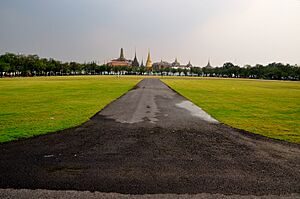
In Thai, this new capital is called Rattanakosin. The shorter names Krung Thep and Krung Thep Maha Nakhon became common later. But foreigners continued to call the city Bangkok.
King Rama I and the kings after him worked to improve the city. They fixed old temples and palaces. New canals were dug, which helped the city grow. More land became available for farming, and new ways to travel were created.
When the city was founded, most people lived by the river or canals. Many lived in floating houses on the water. Waterways were the main way to travel. Outside the city walls, people lived along both sides of the river.
Many Chinese immigrants also came to Bangkok, especially in the early 1800s. They were very important in trade. By 1835, the Chinese area at Sampheng was a busy market.
Modernizing Bangkok
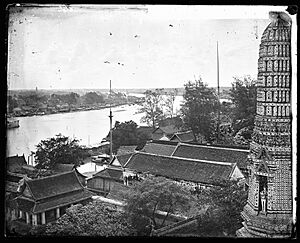
By the mid-1800s, Western countries became very powerful. Missionaries, diplomats, and traders started visiting Bangkok again. They brought new ideas and technology. But they also brought the threat of being taken over by a foreign power.
King Mongkut (Rama IV, 1851–1868) was open to Western ideas. He signed a treaty with Britain in 1855. During his rule, Bangkok started to become more modern. Things like steam engines, modern shipbuilding, and printing presses were introduced.
The first paved street in the city, Charoen Krung Road, was built in 1862–1864. More roads followed, like Bamrung Mueang and Si Lom. Roads became more important than canals for travel. People started living in permanent buildings instead of floating houses. The city also grew bigger, reaching the Phadung Krung Kasem Canal.
King Mongkut's son, Chulalongkorn (1868–1910), wanted to modernize the country even more. He made many changes, like ending slavery and the old feudal system. He created a central government and a professional army. He also adopted Western ideas about nationhood.
Disputes with the French happened in 1893. The French sent warships up the Chao Phraya River to block Bangkok. This made Siam give up some land to France.
Under King Chulalongkorn, the capital and nearby areas were organized under a new ministry. Many more canals and roads were built, making the city even larger. New services like railways and telegraphs were introduced. Electricity came to palaces and government offices first. Then it powered electric trams and later reached the public.
The King liked Western styles. This was seen in royal clothing and especially in architecture. He ordered the building of the Ananta Samakhom Throne Hall. This building was in a Western style. It was connected to the old city center by Ratchadamnoen Avenue, which was inspired by a famous street in Paris. Western influence could be seen all over the city.
Bangkok in the 1900s
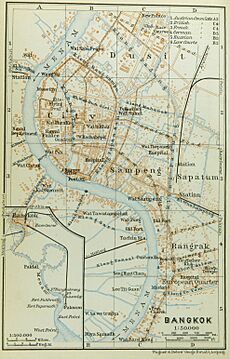
By 1900, rural market areas in Bangkok started to become places where people lived. King Rama VI (1910–1925) continued to develop public works. He started Chulalongkorn University in 1916. He also built a system of locks to control water levels around the city. He created Lumphini Park, the city's first large park.
The Memorial Bridge was built in 1932. It connected Thonburi to Bangkok. This bridge was meant to help the economy grow and bring more modernization.
Bangkok became the main place for political power struggles. In 1932, the country ended its absolute monarchy. During World War II, Bangkok was occupied by Japan and bombed by the Allies. After the war ended in 1945, British and Indian troops arrived.
After the war, Bangkok grew very quickly. The United States helped with development, and the government invested a lot. Roads and the Don Mueang International Airport were built and expanded. Bangkok also became a popular place for American soldiers to rest and relax. This helped start the city's tourism industry.
Many people moved from rural areas to Bangkok. The city's population grew from 1.8 million to 3 million in the 1960s. This fast growth led to problems like huge traffic jams. Bangkok continued to be the center of protests and political changes throughout the late 1900s and early 2000s.
In 1971–1972, eastern Bangkok (called Phra Nakhon) and Thonburi were merged. This created the current city of Bangkok, officially known as Krung Thep Maha Nakhon. The Bangkok Metropolitan Administration (BMA) was created in 1975 to govern the city. The city's governor has been elected since 1985.
Images for kids
-
A map of Bangkok in the 1820s; from the journal of the diplomatic mission to Siam and Cochin-China by John Crawfurd
See also
- History of Thailand
- Siege of Bangkok
- Fortifications of Bangkok
- Bombing of Bangkok in World War II





